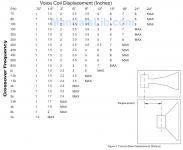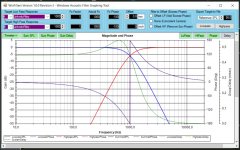SoundRight,Thought I would dabble with analogue again and purchased a Rane 23s. The manual has a chart for "rough" delay settings by crossover frequency and voice coil offset.
My question...why is the amount of delay required different at different frequencies for the same driver offset, which in my case is around 9" as I use a horn and cone mid set up..
With digital delay the delay is independent of frequency.
With an analog delay like the Rane 23s (using some sort of "all pass" filter) the "delay" settings from "1" to "MAX" are not actual delay times, the delay at "MAX" is roughly close to the wavelength (in inches) of the crossover frequency in the chart.
There are no dials on the Rane 23s labeled in milliseconds, similar to Nigel's Marshall that goes to "11" not being labeled in dB ;^).
As the manual states: "The amount of displacement correction available from the delay depends on the actual cross-over frequency: the higher the frequency the less amount of correction capability."
Because of the taper of the pots and circuits used, reducing the number by half also won't result in exactly half the distance/time.
The wavelength of a frequency in inches can be determined by dividing 1130 (speed of sound in feet per second) by the frequency.
Looking at the Rane "Voice Coil Displacement (Inches)" chart, we see the "MAX" delay setting at 6kHz to be 3", the actual wavelength of 6kHz is 1.9", which is closer to 3" than 1.5" or 6", the adjacent choices.
Dropping an octave to 3kHz, the actual wavelength is 4.52", so 6" requires "MAX", while 3" only requires a setting of "2.4".
At 800 Hz, almost another octave drop, the wavelength is 16.95", requiring the "MAX" setting for 15", but not quite enough delay available to achieve 18" of delay.
To "dial in" delay (phase) settings on a unit of this sort really requires some measurement, as the manual explains in detail.
Art
Attachments
Last edited:
it's more like bringing two sources that are separated by distance or time (they are almost interchangeable in this instance) back to coherence in time i.e. additive and not substractive this is why i mentioned earlier that it's a complex relationship between frequency and distance over time and in real time the clock on all three is running (not to mention that phase of each frequency is varying not merely between 0 and 180 it's 360 so it's far more complex) to wit it's not merely a phase shift it's a rotation and group delay can make this an even bigger mess.
Turk, complicated indeed!
Fourier Transform, Fourier Series, and frequency spectrum - YouTube
as i'm not fully familiar with the DCX i can't say that it calculates the phase but the window your showing seems to indicate a phase angle can be specified.
Guys i think the mystical non linear delay is shown in this graph. Green 😀
App is here:
David Ralph's Speaker Pages - WinGraph Release Information
App is here:
David Ralph's Speaker Pages - WinGraph Release Information


